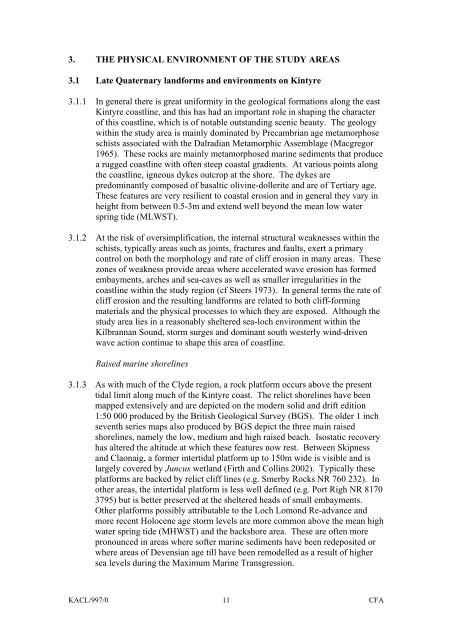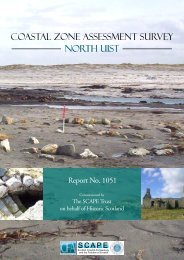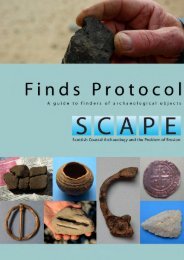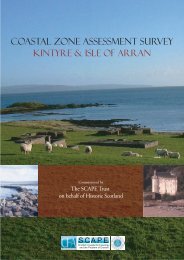download - SCAPE
download - SCAPE
download - SCAPE
Create successful ePaper yourself
Turn your PDF publications into a flip-book with our unique Google optimized e-Paper software.
3. THE PHYSICAL ENVIRONMENT OF THE STUDY AREAS<br />
3.1 Late Quaternary landforms and environments on Kintyre<br />
3.1.1 In general there is great uniformity in the geological formations along the east<br />
Kintyre coastline, and this has had an important role in shaping the character<br />
of this coastline, which is of notable outstanding scenic beauty. The geology<br />
within the study area is mainly dominated by Precambrian age metamorphose<br />
schists associated with the Dalradian Metamorphic Assemblage (Macgregor<br />
1965). These rocks are mainly metamorphosed marine sediments that produce<br />
a rugged coastline with often steep coastal gradients. At various points along<br />
the coastline, igneous dykes outcrop at the shore. The dykes are<br />
predominantly composed of basaltic olivine-dollerite and are of Tertiary age.<br />
These features are very resilient to coastal erosion and in general they vary in<br />
height from between 0.5-3m and extend well beyond the mean low water<br />
spring tide (MLWST).<br />
3.1.2 At the risk of oversimplification, the internal structural weaknesses within the<br />
schists, typically areas such as joints, fractures and faults, exert a primary<br />
control on both the morphology and rate of cliff erosion in many areas. These<br />
zones of weakness provide areas where accelerated wave erosion has formed<br />
embayments, arches and sea-caves as well as smaller irregularities in the<br />
coastline within the study region (cf Steers 1973). In general terms the rate of<br />
cliff erosion and the resulting landforms are related to both cliff-forming<br />
materials and the physical processes to which they are exposed. Although the<br />
study area lies in a reasonably sheltered sea-loch environment within the<br />
Kilbrannan Sound, storm surges and dominant south westerly wind-driven<br />
wave action continue to shape this area of coastline.<br />
Raised marine shorelines<br />
3.1.3 As with much of the Clyde region, a rock platform occurs above the present<br />
tidal limit along much of the Kintyre coast. The relict shorelines have been<br />
mapped extensively and are depicted on the modern solid and drift edition<br />
1:50 000 produced by the British Geological Survey (BGS). The older 1 inch<br />
seventh series maps also produced by BGS depict the three main raised<br />
shorelines, namely the low, medium and high raised beach. Isostatic recovery<br />
has altered the altitude at which these features now rest. Between Skipness<br />
and Claonaig, a former intertidal platform up to 150m wide is visible and is<br />
largely covered by Juncus wetland (Firth and Collins 2002). Typically these<br />
platforms are backed by relict cliff lines (e.g. Smerby Rocks NR 760 232). In<br />
other areas, the intertidal platform is less well defined (e.g. Port Righ NR 8170<br />
3795) but is better preserved at the sheltered heads of small embayments.<br />
Other platforms possibly attributable to the Loch Lomond Re-advance and<br />
more recent Holocene age storm levels are more common above the mean high<br />
water spring tide (MHWST) and the backshore area. These are often more<br />
pronounced in areas where softer marine sediments have been redeposited or<br />
where areas of Devensian age till have been remodelled as a result of higher<br />
sea levels during the Maximum Marine Transgression.<br />
KACL/997/0<br />
11<br />
CFA









